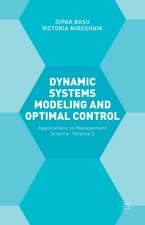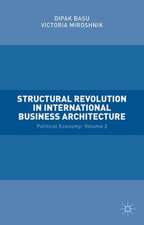Structural Revolution in International Business Architecture, Volume 1: Modelling and Analysis
Autor Victoria Miroshnik, Dipak Basuen Limba Engleză Hardback – 8 dec 2015
Preț: 640.37 lei
Preț vechi: 753.39 lei
-15% Nou
Puncte Express: 961
Preț estimativ în valută:
122.55€ • 133.07$ • 102.94£
122.55€ • 133.07$ • 102.94£
Carte tipărită la comandă
Livrare economică 23 aprilie-07 mai
Preluare comenzi: 021 569.72.76
Specificații
ISBN-13: 9781137535641
ISBN-10: 1137535644
Pagini: 240
Ilustrații: XI, 221 p.
Dimensiuni: 140 x 216 x 14 mm
Greutate: 0.42 kg
Ediția:1st ed. 2015
Editura: Palgrave Macmillan UK
Colecția Palgrave Macmillan
Locul publicării:London, United Kingdom
ISBN-10: 1137535644
Pagini: 240
Ilustrații: XI, 221 p.
Dimensiuni: 140 x 216 x 14 mm
Greutate: 0.42 kg
Ediția:1st ed. 2015
Editura: Palgrave Macmillan UK
Colecția Palgrave Macmillan
Locul publicării:London, United Kingdom
Cuprins
Introduction
1. Structural Reforms in International Business and Production
2. Tariff Policy and Employment Structure in the UK
3. Structural Reforms in China
4. Structural Reforms in India
5. Structural Reforms in Nigeria
6. Structural Reforms in Egypt
Conclusion
1. Structural Reforms in International Business and Production
2. Tariff Policy and Employment Structure in the UK
3. Structural Reforms in China
4. Structural Reforms in India
5. Structural Reforms in Nigeria
6. Structural Reforms in Egypt
Conclusion
Notă biografică
Dipak Basu is Professor in International Economics in Nagasaki University, Japan. Previously he was lecturer in the Institute of Agricultural Economics at Oxford University, Research Officer in the Department of Applied Economics at Cambridge University, Senior Economist in Charge of the Middle East & Africa division of Standard & Poor, and Senior Economist in the Ministry of Foreign Affairs of Saudi Arabia. He is a member of the editorial board of International Journal of Decision Sciences, Risk and Management and was the editor of the Middle East & Africa Review. He has received his PhD from the University of Birmingham, UK.
Victoria W. Miroshnik is Associate Professor in Management, Tsukuba University Graduate School of Management, Tokyo, Japan. She was awarded the Adam Smith Research Fellowship from the University of Glasgow, UK and was previously Associate Professor in Management at Keimyung University, South Korea; American University Dubai; Ritsumeikan Asia-Pacific University, Japan; and a psychologist in the Military Academy of USSR in Tbilisi, Georgia.
Victoria W. Miroshnik is Associate Professor in Management, Tsukuba University Graduate School of Management, Tokyo, Japan. She was awarded the Adam Smith Research Fellowship from the University of Glasgow, UK and was previously Associate Professor in Management at Keimyung University, South Korea; American University Dubai; Ritsumeikan Asia-Pacific University, Japan; and a psychologist in the Military Academy of USSR in Tbilisi, Georgia.
Textul de pe ultima copertă
Most of the established theories of economics, particularly of international trade, became obsolete in the new world trade and production architecture. How, in these new circumstances, will host nations organize their economic resources?
Structural Revolution in International Business Architecture analyzes some prominent countries in the world to examine the issue from two specific points of views. The first is to answer the question of whether it was necessary to dismantle the old system and privatize the economy rather than utilizing the traditional stabilization policy through monetary and fiscal instruments, when crisis appeared in the late 1980s and early 1990s mainly due to the demise of the Soviet Union and the Eastern European economic union causing serious disruptions in world trade, and the resultant war and destructions in various parts of the world. The second objective is to examine whether there was any alternative way. In this book, in the analysis of the recent globalization, the authors have used the simulations of economy-wide models to analyze alternative policy frameworks for the economies of the UK, China, India, Nigeria, and Egypt to re-examine the relative merits of alternative economic and trade policy regimes, through economy-wide models.
Structural Revolution in International Business Architecture analyzes some prominent countries in the world to examine the issue from two specific points of views. The first is to answer the question of whether it was necessary to dismantle the old system and privatize the economy rather than utilizing the traditional stabilization policy through monetary and fiscal instruments, when crisis appeared in the late 1980s and early 1990s mainly due to the demise of the Soviet Union and the Eastern European economic union causing serious disruptions in world trade, and the resultant war and destructions in various parts of the world. The second objective is to examine whether there was any alternative way. In this book, in the analysis of the recent globalization, the authors have used the simulations of economy-wide models to analyze alternative policy frameworks for the economies of the UK, China, India, Nigeria, and Egypt to re-examine the relative merits of alternative economic and trade policy regimes, through economy-wide models.





















